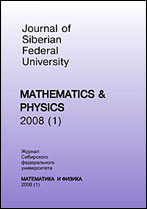|
This article is cited in 7 scientific papers (total in 7 papers)
Theoretical study of electrolyte diffusion through polarizable nanopores
Ilya I. Ryzhkovab, Anton S. Vyatkinab, Andrey V. Minakovc
a Institute of Computational Modelling SB RAS,
Academgorodok, 50/44 Krasnoyarsk, 660036, Russia
b Siberian Federal University,
Svobodny, 79, Krasnoyarsk, 660041,
Russia
c Institute of Engineering Physics and Radio Electronics,
Siberian Federal University,
Svobodny, 79, Krasnoyarsk, 660041,
Russia
Abstract:
The diffusion of binary aqueous electrolytes through nanopores with dielectric as well as conductive surface is investigated theoretically on the basis of Space–Charge model. The latter is extended to the case of polarizable nanopore wall. It is shown that the diffusion of ions with different mobilities generates the electric field, which induces non–uniform surface charge in a polarizable nanopore. It results in charge separation inside the pore and leads to a dramatic enhancement of membrane potential in comparison with a non-polarizable nanopore. The calculations are performed for three aqueous electrolytes based on KCl, NaCl, and LiOH. The influence of electrolyte type and concentration difference applied across the pore on the ion transport and membrane potential is discussed and analyzed.
Keywords:
nanoporous membrane, electrolyte transport, diffusion, induced charge, electric double layer, membrane potential, numerical modelling.
Received: 07.11.2017
Received in revised form: 06.12.2018
Accepted: 20.06.2018
Citation:
Ilya I. Ryzhkov, Anton S. Vyatkin, Andrey V. Minakov, “Theoretical study of electrolyte diffusion through polarizable nanopores”, J. Sib. Fed. Univ. Math. Phys., 11:4 (2018), 494–504
Linking options:
https://www.mathnet.ru/eng/jsfu690 https://www.mathnet.ru/eng/jsfu/v11/i4/p494
|

| Statistics & downloads: |
| Abstract page: | 257 | | Full-text PDF : | 69 | | References: | 54 |
|



 Contact us:
Contact us: Terms of Use
Terms of Use
 Registration to the website
Registration to the website Logotypes
Logotypes